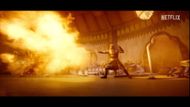The live-action version of Avatar: The Last Airbender on Netflix may be heading in a direction that, at first glance, doesn’t seem drastic. But then it sinks in. One of the biggest changes could come from how early firebending takes center stage. In the animated series, fire remained more of a looming backdrop until the third season. Aang only began learning it properly when everything else was already unraveling. That long buildup gave the element weight.
This time, though, the shift may happen sooner. Season 2 seems like it’s not going to wait. That choice pulls firebending out from behind the curtain and places it right into the middle of the story. Before many of the things that used to come first even get the chance to unfold fully.
And that says a lot about what kind of series this version wants to become.
Fire steps forward in Avatar: The Last Airbender
In the original animation, the elements followed a rhythm. Water, earth, fire. That was the natural order. The storytelling respected that flow. Aang’s fear of fire wasn’t just about the element itself. It symbolized danger, destruction, and responsibility. His resistance was emotional, not just strategic. So when firebending finally became part of his learning process, the stakes were already high.
The live-action version of Avatar: The Last Airbender on Netflix may be heading in a direction that, at first glance, doesn't seem drastic. But then it sinks. It might come in the middle of confusion, loss, and incomplete training. That makes the energy different — less structured, more volatile. Characters like Zuko and Azula might move forward faster, not only as symbols of opposition, but as pieces of the story that are constantly pulling things out of place.
Zuko’s internal conflict, usually simmering in the background until later episodes, could erupt earlier. His connection to Aang, his slow path toward change, might begin before we even realize it’s happening.

A shift in tone and pacing
Bloodbending may also appear ahead of schedule. In the original animation, this rare and haunting ability showed up in later episodes. It was meant to disturb. And it did so, quietly, but effectively. Now, small glimpses of it could emerge earlier. Prisoners. Experiments. Something just out of frame. It doesn’t need to be obvious to change how the story feels.
That early inclusion, if it happens, would push Avatar: The Last Airbender even further into a heavier tone. Not necessarily darker just for the sake of it. But darker in a way that challenges how these powers are understood. Bending isn’t always beautiful. Sometimes it’s control. Sometimes it hurts.
The pacing reflects that, too. With fewer episodes per season, the structure shifts. Events get tighter. Space to pause becomes rare. What used to build across multiple episodes now lands faster. It changes the viewer’s experience, with less wandering, more urgency; less quiet, more pressure.
Familiar characters, but not quite the same
Toph is one name that keeps coming up. Fans have strong memories of her —blind, stubborn, brilliant. In the animated version, her journey was rooted in rejection and self-discovery. She invented metalbending because no one told her she couldn’t, or maybe because everyone did.
In this adaptation of Avatar: The Last Airbender, early reports suggest Toph might already show signs of mastering that skill. Actress Miya Cech mentioned changes, and that’s enough to spark curiosity. If she enters the story already powerful, her arc shifts in another direction. The challenge becomes different. It becomes less about discovering strength and more about understanding what to do with it.
That reflects a broader shift in the adaptation. This isn’t about breaking characters. It’s about reworking how they arrive where they’re meant to be. The emotional core remains intact. The beats just land in new places.

The mood of Season 2
The first season served a clear purpose — to introduce, establish, and guide. The tone was still taking shape. Now, Season 2 seems set to push forward, not in a rush, but with less hesitation. Decisions will weigh more. Relationships will stretch under pressure, and so the story might stop circling and start colliding.
This is where the war feels closer. Not just because of firebending, but because the characters are no longer preparing. They’re already in it. That removes the safety of distance. In Avatar: The Last Airbender, that shift matters. The second season may not allow room for waiting, and that changes everything, even for those who already know the outcome.
What’s happening offscreen
Netflix confirmed additional seasons quickly after Season 1. Seasons 2, 3, and 4 are on the schedule. That kind of commitment hints at long-term planning. Most of the original cast is reportedly returning. Azula becomes a bigger part of the picture. Daniel Dae Kim mentioned that things feel different this time around.
There’s no official release window, but 2026 is being mentioned. Nothing is official yet, but it aligns with the timeline required for post-production on a show of this size. The scope is large in terms of visual effects and world-building, all of which takes time.

Avatar: The Last Airbender adapts without letting go
This version of Avatar: The Last Airbender doesn’t aim to replace the original. It knows that’s not possible. What it’s doing is choosing another route to reach familiar places. The changes aren’t random. They speak to a different rhythm, a different viewing format, and a different kind of storytelling.
The foundation stays. The characters carry echoes of their animated selves. But the path they walk isn’t identical. It doesn’t need to be. For a story about balance and tension between the past and present, maybe it makes sense for the adaptation to live in that space, too — somewhere between what was and what could be.
